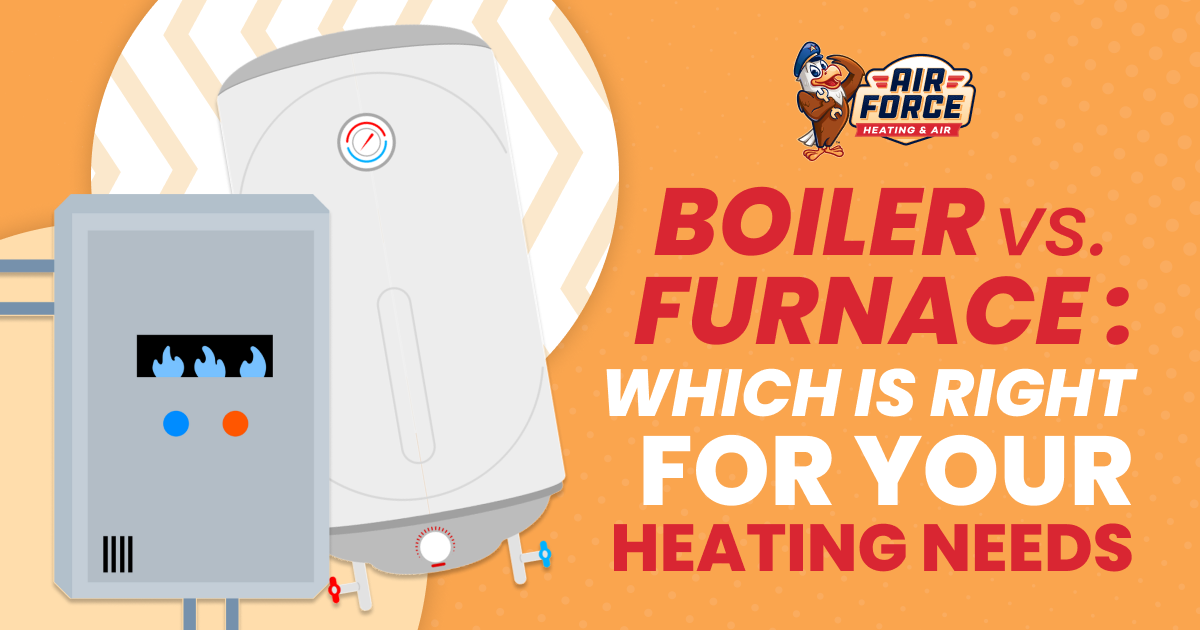Heating your home efficiently and comfortably is essential, especially during those cold winter months. The choice between a boiler and a furnace can significantly impact your heating experience and the comfort levels in your home. Both systems have distinct features, installation, processes, and costs.
In this blog, we’ll explore the key differences between boilers and furnaces, discuss their installation procedures, and provide insight into the costs involved. Whether you’re replacing an old system, or setting up a new one, understand the pros and cons of boilers and furnaces. It will help you make a better decision for your home.
Basic Overview of Boilers vs. Furnaces
Before we dive into discussing the installation and costs of the two heating units, we first want to provide you with some basic knowledge about boilers and furnaces.
Boilers
Boilers or heating systems that use either water or steam to distribute heat throughout your home. They are known for their efficiency, even heating, and longevity. Here are the key features of boilers:
Water or Steam
Boilers, heat, water, or produce steam, which is then circulated through pipes and radiators or underfloor tubing to provide warmth.
Even-Heat
Boilers offer consistent and even heating because they distribute heat evenly through radiators or radiant floor systems.
Durability
Boilers are known for their durability and can last for many years with proper maintenance.
Energy Efficiency
Boilers are often considered more energy efficient than furnaces, due to the gentle, radiant heat they provide.
Furnaces
Furnaces use forced air systems to heat your home. They heat air and distribute it through ducks to various roofs. Here are some of the key features to know about furnaces:
Forced Air
Furnaces use a blower to circulate heated air through ductwork, providing quick and powerful heating.
Versatility
Furnaces can be used for central air conditioning, providing heating and cooling in one system.
Affordability
Furnaces are generally more affordable to install compared to boilers.
Maintenance
Furnaces require more frequent maintenance than boilers due to their air filters and ducts.
Now that we have some basic knowledge of the characteristics of both boilers and furnaces, we can dive into exploring the different installation processes for each unit.
Boiler Installation
Gas Boiler Installation
If you’ve chosen a gas boiler for your home, here’s what you can expect during the installation process:
Assessment
A professional technician will assess your home to determine the right boiler size and location for installation.
Piping and Ventilation
Gas boilers require gas, lines, and ventilation systems. These are installed to ensure safe operation.
Boiler Installation
The boiler itself will be installed, along with any necessary piping and connections. This can be a complex process that requires the licensed knowledge and skill of a boiler technician.
Testing
Once the boiler is installed, the system will be thoroughly tested to ensure it’s functioning correctly and safely.
Electric boilers are installed similarly but are a bit less labor-intensive because they do not require gas lines and ventilation systems. They are easier to install than gas boilers and are perfect if your home isn’t equipped with gas.
Furnace Installation
Gas Furnace Installation
Gas furnaces are popular for heating homes due to their efficiency and affordability. Here’s what their installation process looks like:
Sizing and Ductwork
Similar to boilers, a technician will assess your home size and he needs to determine the right furnace size. They will also inspect and install ductwork if necessary.
Gas Line and Ventilation
A gas line is installed if your furnace uses natural gas. Proper ventilation and exhaust systems are set up for safe operation as well.
Furnace Installation
Once the gas lines and ventilation systems are ready to go, the furnace will then be installed. It’ll be connected to the ducks and hooked up to the thermostat.
Testing
The entire system is thoroughly tested to ensure operation of the unit is safe and reliable.
Just like electric boilers, electric furnaces are far easier to install because they don’t require gas lines or ventilation either. They are a very suitable choice for those homes that are powered by electricity.
Boiler Installation Cost
The cost of installing a new boiler Convery significantly, depending on factors like the type of the boiler, its size, and the complexity of the installation.
On average, you can expect to pay between $3000 and $7500 for gas boiler installation.
If you choose to go with an electric boiler, you can expect the installation costs to range between $1500 and $3500.
Furnace Installation Cost
The installation cost for a gas furnace typically falls in the range of $2500 and $7500, depending on factors like the furnace, efficiency, size, and installation complexity. Electric furnaces are generally cheaper to install with costs ranging between $1000-$3500.
Tax Credits for High-Tier Efficiency HVAC Products
No matter how you look at it, installing a new boiler or furnace is not a very cheap thing to do. Most people dread making this decision because rarely does anyone have extra thousands of dollars lying around. However, keep in mind that the government issued the Inflation Reduction Act of 2022, which provides tax credits for those consumers who choose to buy a high-tier, efficient, furnace, or boiler for their home.
Boiler and Furnace Installation for Your Home
Are you in need of a new boiler or furnace for your home? Don’t be stuck in the cold and cold air force heating and air today. With our expert team of furnace and boiler technicians, you will get the assistance you need to ensure that your home is safe and comfortable throughout the winter months.

